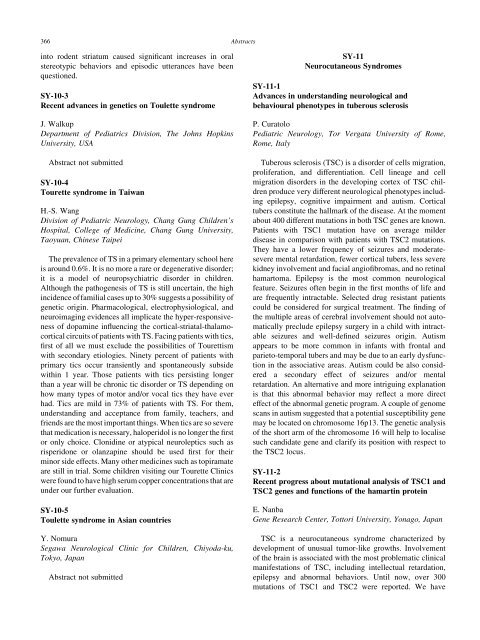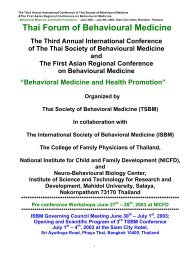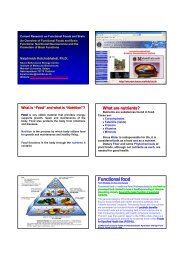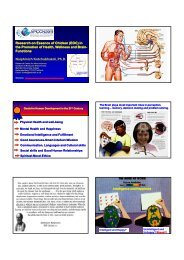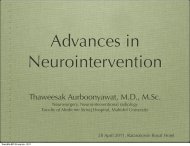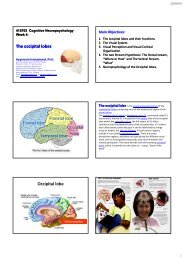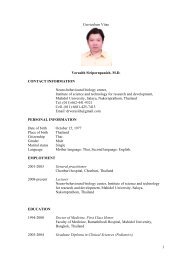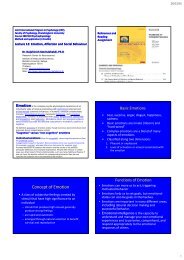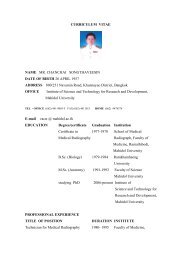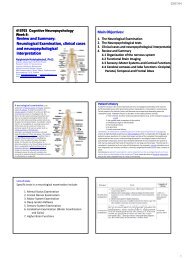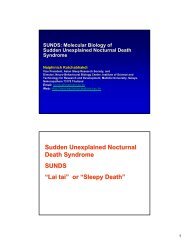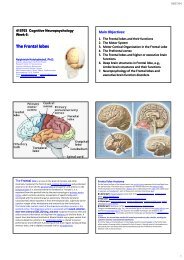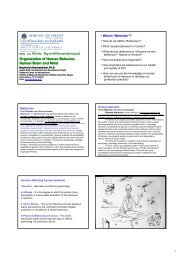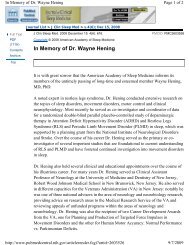PDF File - Mahidol University
PDF File - Mahidol University
PDF File - Mahidol University
Create successful ePaper yourself
Turn your PDF publications into a flip-book with our unique Google optimized e-Paper software.
366<br />
Abstracts<br />
into rodent striatum caused significant increases in oral<br />
stereotypic behaviors and episodic utterances have been<br />
questioned.<br />
SY-10-3<br />
Recent advances in genetics on Toulette syndrome<br />
J. Walkup<br />
Department of Pediatrics Division, The Johns Hopkins<br />
<strong>University</strong>, USA<br />
Abstract not submitted<br />
SY-10-4<br />
Tourette syndrome in Taiwan<br />
H.-S. Wang<br />
Division of Pediatric Neurology, Chang Gung Children’s<br />
Hospital, College of Medicine, Chang Gung <strong>University</strong>,<br />
Taoyuan, Chinese Taipei<br />
The prevalence of TS in a primary elementary school here<br />
is around 0.6%. It is no more a rare or degenerative disorder;<br />
it is a model of neuropsychiatric disorder in children.<br />
Although the pathogenesis of TS is still uncertain, the high<br />
incidence offamilial cases up to 30% suggests a possibility of<br />
genetic origin. Pharmacological, electrophysiological, and<br />
neuroimaging evidences all implicate the hyper-responsiveness<br />
of dopamine influencing the cortical-striatal-thalamocortical<br />
circuits of patients with TS. Facing patients with tics,<br />
first of all we must exclude the possibilities of Tourettism<br />
with secondary etiologies. Ninety percent of patients with<br />
primary tics occur transiently and spontaneously subside<br />
within 1 year. Those patients with tics persisting longer<br />
than a year will be chronic tic disorder or TS depending on<br />
how many types of motor and/or vocal tics they have ever<br />
had. Tics are mild in 73% of patients with TS. For them,<br />
understanding and acceptance from family, teachers, and<br />
friends are the most important things. When tics are so severe<br />
that medication is necessary, haloperidol is no longer the first<br />
or only choice. Clonidine or atypical neuroleptics such as<br />
risperidone or olanzapine should be used first for their<br />
minor side effects. Many other medicines such as topiramate<br />
are still in trial. Some children visiting our Tourette Clinics<br />
were found to have high serum copper concentrations that are<br />
under our further evaluation.<br />
SY-10-5<br />
Toulette syndrome in Asian countries<br />
Y. Nomura<br />
Segawa Neurological Clinic for Children, Chiyoda-ku,<br />
Tokyo, Japan<br />
Abstract not submitted<br />
SY-11<br />
Neurocutaneous Syndromes<br />
SY-11-1<br />
Advances in understanding neurological and<br />
behavioural phenotypes in tuberous sclerosis<br />
P. Curatolo<br />
Pediatric Neurology, Tor Vergata <strong>University</strong> of Rome,<br />
Rome, Italy<br />
Tuberous sclerosis (TSC) is a disorder of cells migration,<br />
proliferation, and differentiation. Cell lineage and cell<br />
migration disorders in the developing cortex of TSC children<br />
produce very different neurological phenotypes including<br />
epilepsy, cognitive impairment and autism. Cortical<br />
tubers constitute the hallmark of the disease. At the moment<br />
about 400 different mutations in both TSC genes are known.<br />
Patients with TSC1 mutation have on average milder<br />
disease in comparison with patients with TSC2 mutations.<br />
They have a lower frequency of seizures and moderatesevere<br />
mental retardation, fewer cortical tubers, less severe<br />
kidney involvement and facial angiofibromas, and no retinal<br />
hamartoma. Epilepsy is the most common neurological<br />
feature. Seizures often begin in the first months of life and<br />
are frequently intractable. Selected drug resistant patients<br />
could be considered for surgical treatment. The finding of<br />
the multiple areas of cerebral involvement should not automatically<br />
preclude epilepsy surgery in a child with intractable<br />
seizures and well-defined seizures origin. Autism<br />
appears to be more common in infants with frontal and<br />
parieto-temporal tubers and may be due to an early dysfunction<br />
in the associative areas. Autism could be also considered<br />
a secondary effect of seizures and/or mental<br />
retardation. An alternative and more intriguing explanation<br />
is that this abnormal behavior may reflect a more direct<br />
effect of the abnormal genetic program. A couple of genome<br />
scans in autism suggested that a potential susceptibility gene<br />
may be located on chromosome 16p13. The genetic analysis<br />
of the short arm of the chromosome 16 will help to localise<br />
such candidate gene and clarify its position with respect to<br />
the TSC2 locus.<br />
SY-11-2<br />
Recent progress about mutational analysis of TSC1 and<br />
TSC2 genes and functions of the hamartin protein<br />
E. Nanba<br />
Gene Research Center, Tottori <strong>University</strong>, Yonago, Japan<br />
TSC is a neurocutaneous syndrome characterized by<br />
development of unusual tumor-like growths. Involvement<br />
of the brain is associated with the most problematic clinical<br />
manifestations of TSC, including intellectual retardation,<br />
epilepsy and abnormal behaviors. Until now, over 300<br />
mutations of TSC1 and TSC2 were reported. We have


